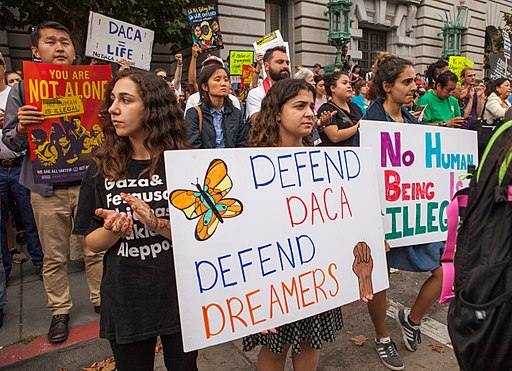Luis Javier Pentón Herrera & Nicole Obregón
Published online: 10 Oct 2018
To cite this article: Luis Javier Pentón Herrera & Nicole Obregón (2018): Challenges facing
Latinx ESOL students in the Trump era: Stories told through testimonios, Journal of Latinos and Education, DOI: 10.1080/15348431.2018.1523793
To link to this article: https://doi.org/10.1080/15348431.2018.1523793
ABSTRACT
In this essay, two ESOL teachers reflect on the implications of the DACA program and the DREAM Act for undocumented Latinx ELs, their families, and their communities in the United States. Six testimonios from real undocumented ELs are shared with the vision of illustrating the real-life struggles these students and their families are exposed to in the Trump era. The authors’ vision is that these testimonios will shed light on the realities their students experience and will combat stereotypical beliefs that Latinx ELs/immigrants are uneducated, do not value education, cannot learn English, and have a poor work ethic.
KEY WORDS
DACA; DREAM Act; education; ELs; Latinx students; testimonios
Give me your tired, your poor,
Your huddled masses yearning to breathe free,
The wretched refuse of your teeming shore.
Send these, the homeless, tempest-tossed, to me:
I lift my lamp beside the golden door.
–Emma Lazarus
Introduction
President Trump’s election has set into motion a new reality for Latinx immigrants in the United States, especially for Latinx students who are undocumented and seeking a pathway to a safe and secure life without barriers to education and employment. The DACA program was established under President Obama’s leadership in 2012 with the intention of protecting undocumented immigrant minors who entered the U.S. before the age of 16 and allowing them to stay in the country legally without the fear of deportation. In addition to DACA, President Obama sought to enact the Development, Relief, and Education for Alien Minors (DREAM) Act of 2017 with the objective of providing a path to residency, and eventually citizenship (Graham, 2017) to those who qualified. Although the DREAM Act has bipartisan support, it still has not passed, putting the lives of Latinx minors and other DREAMers at risk for deportation and separation from immediate family members. Since the 2016 presidential election, educational and non-educational policies that directly attack the rights, opportunities, and equality of Latinx immigrant students in the United States have been implemented.
The DREAM Act and DACA programs are vital for communities to thrive. DACA gives
undocumented immigrants who arrived as minors temporary legal protection from deportation and the opportunity to obtain lawful employment, whereas unprotected undocumented immigrants must seek a source of income that typically involves manual, lower-skill and lower-paying occupations (Uwemedimo, Monterrey, & Linton, 2017). While DACA provides temporary legal protection from deportation and the lawful provision of employment, the DREAM Act specifically addresses the necessity for undocumented minors to continue living a productive life as part of an American community in the United States. DREAMers would be granted permanent resident status in the country if they are actively enrolled in public school or higher education, have secured employment, or have served in the United States military (Graham, 2017). Additionally, the DREAM Act would improve college affordability by allowing recipients to pay in-state college tuition and gain access to financial aid that is currently inaccessible to unprotected youth (Wong et al., 2017).
